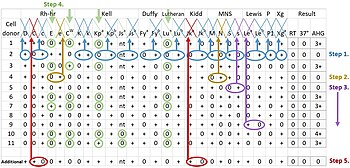Diego antigen system

The Diego antigen (or blood group) system is composed of 21 blood factors or
Types
The Diego system is named after a pair of types, Diegoa (Dia) and Diegob (Dib), which differ by one
The Wright blood system is another pair of types, Wrighta (Wra) and Wrightb (Wrb), also differing by one amino acid on the AE1 glycoprotein and one nucleotide on the SLC4A1 gene. Wra always expresses antigens, but the antibody reaction of Wrb depends on a variation in the structure of
Seventeen other rare blood types (as of 2002) are included in the Diego antigen system, as they are produced by mutations on the SLC4A1 gene. These include the Waldner (Wda), Redelberger (Rba), Warrior (WARR), ELO, Wulfsberg (Wu), Bishop (Bpa), Moen (Moa), Hughes (Hua), van Vugt (Vga), Swann (Swa), Bowyer (BOW), NFLD, Nunhart (Jna), KREP, Traversu (Tra), Froese (Fra) and SW1 types.[4]
List of Diego antigens
| ISBT | Symbol | Historical name | Substitution |
|---|---|---|---|
| DI1 | Dia | Diego a | Leu 854 |
| DI2 | Dib | Diego b | Pro 854 |
| DI3 | Wra | Wright a | Lys 658 |
| DI4 | Wrb | Wright b | Glu 658
|
| DI5 | Wda | Waldner | Val 557 Met |
| DI6 | Rba | Radelberger | Pro 548 Met |
| DI7 | WARR | Warrior | Thr 552 Ile |
| DI8 | ELO | Trp
| |
| DI9 | Wu | Wulfsberg | Gly 565 Ala |
| DI10 | Bpa | Bishop | Asn 569 Lys
|
| DI11 | Moa | Moen | Arg 656 Cys |
| DI12 | Hga | Hughes | Tyr 555 His |
| DI13 | Uga | van Vugt | Arg 646 Gln |
| DI14 | Swa | Swann | Pro 561 Ser |
| DI15 | BOW | Bowyer | Pro 561 Ser |
| DI16 | NFLD | Glu 429 Asp Pro 561 Ala | |
| DI17 | Jna | Nunhart | Pro 566 Ser |
| DI18 | KREP | Pro 566 Ala | |
| DI19 | Tra | Traversu | Lys 551 Asn |
| DI20 | Fra | Froese | Glu 480 Lys |
| DI21 | SW1 | Arg 646 Trp | |
| DI22 | DISK | Gly 565 Ala | |
| [1][4][5] | |||
History
The first Diego antigen, Dia, was discovered in 1953, when a child in
The Wrighta antigen (Wra), a very low frequency blood type, was also discovered in 1953. The Wrightb antigen (Wrb), a very high frequency blood type, was discovered about a decade later, but the two types were not recognized as a pair for another 20 years. The Wright group was eventually identified as a single point mutation on the SLC4A1 gene. The Wright group was subsumed into the Diego group in 1995, since its location on the SLC4A1 gene had been determined after the Diego group had been located there.[2]
Starting in 1995, various rare antigen types, some of which had been known for 30 years, were found to also be caused by mutations on the SLC4A1 gene, and were therefore added to the Diego system.[2]
Distribution of the Diegoa antigen
The Dib antigen has been found in all populations tested. The Dia antigen, however, has been found only in populations of
While the Dia antigen is found at moderate to high frequencies in most populations of indigenous peoples in South America, it is absent in the
Samples of groups in
The Dia antigen is widespread in East Asian populations. Samples of East Asian populations show 4% Dia+ for the
The Dia antigen is also found in northern
The Dia antigen is very rare in
The distribution of the Dia antigen has been cited as proof that the Americas were populated by migrations from Siberia. Differences in the frequency of the antigen in populations of indigenous people in the Americas correlate with major language families, modified by environmental conditions.[14] Another study suggests that the distribution of the Dia antigen in central and eastern Asia has been shaped by the expansion of Mongolian and related populations that resulted in the creation of the Mongol Empire in the 13th- and 14th-centuries.[15]
References
- ^ . Retrieved 10 September 2013.
- ^ PMID 15373634.
- PMID 8611724.
- ^ ISBN 978-3-7091-7244-5.
- ^ Dean L. Blood Groups and Red Cell Antigens [Internet]. Bethesda (MD): National Center for Biotechnology Information (US); 2005. Chapter 11, The Diego blood group. Available from: https://www.ncbi.nlm.nih.gov/books/NBK2273/
- S2CID 37557452.
- ^ PMID 13827615.
- ISBN 978-0-521-21399-8. Retrieved 16 September 2013.
- ISBN 9781109061741. Retrieved 16 September 2013.
- S2CID 5591960.
- ^ ISBN 978-0-521-22213-6. Retrieved 14 September 2013.
- ^ PMID 23559760.
- PMID 8504238.
- PMID 26148209.
- PMID 30143806.
